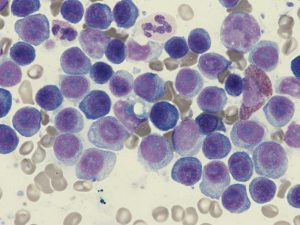The Concept of the Disease
Myeloma is a tumour of bone marrow plasma cells. These cells arise from germinal centre B-cells and typically secrete IgG or IgA.
How is it Diagnosed?
Myeloma is a clinical syndrome and several components are required for diagnosis.
Bone Marrow
- The normal marrow is infiltrated by neoplastic plasma cells, typically a 10% cut-off is used.
- These cells are monoclonal and have an abnormal phenotype and so can be readily distinguished from equivalent normal cells using flow cytometry
Morphology




Pattern of Disease
- End-organ damage which includes bone lesions, anaemia and renal failure. This is sometimes due to light chain amyloid.Pattern of Disease
Immunoglobulin Levels
- The presence of monoclonal immunoglobulin (paraprotein) secreted by the tumour cells; this is an approximate measure of disease bulk
- Suppression of normal immunoglobulin production
The term asymptomatic myeloma is often used to describe patients who fulfil the other criteria but do not have end organ damage.
Monoclonal gammopathy of undetermined significance (MGUS) is used for patients who have lower levels of marrow infiltration by neoplastic plasma cells and paraprotein. This is a very common finding in the general population.
Some patients present with one or more localised tumour deposits (plasmacytoma) with only very low levels of generalised marrow disease.
What is the Clinical Outcome?
The treatment of patients with myeloma has improved considerably with an increased range of treatment options. Many patients have a prolonged survival but require multiple episodes of chemotherapy or radiotherapy. The key determinant of outcome is the level of response to treatment measure by the serum paraprotein level and the detection of residual malignant plasma cells in the bone marrow using sensitive flow cytometry.

